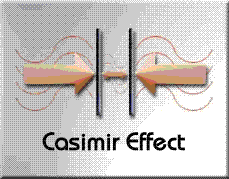The
Casimir effect was postulated in 1948 by the Dutch physicist Hendrick Casimir and it can nowadays be considered one of
the one of the few macroscopic effects of the quantum mechanics. The phenomenology
of the effect is simple: between two conductor plates NOT electrically charged
(that for simplicity we will consider plain) leaned out a strength attraction
is practiced: such strength cannot be explained with any classic phenomenon.
The explanation of the phenomenon is instead not so simple: it has to do with
the way according to which the void in
the quantum mechanics is defined.
In the classical physics a
region of space in which particles or fields are not present is defined as empty; in quantum physics,
because of the principle of indetermination it is impossible to guarantee the
complete absence of particles and/or fields in a region of the space: the void
cannot be considered a zero-energy state because of the quantistic fluctuations
behaving the creation and destruction of virtual particles that, in addiction,
they live weary of brief time, but finite.
Since analogous
phenomenons in the experience and in the every day life don't exist we can try
to imagine analogies that, because of some things, they will not be
rigorous in the description of the
phenomenon in matter.
Let's imagine the
quantistic void is a state in which some little balls are continually formed
and disappeared; to fix our ideas let's think of something as a bead of soap
(but supposed to be rigid) that it is
born and after a certain time it bursts. Let's suppose besides that the more
the ray of the little balls is little the more heavy the balls are.
If we imagine to have a solid surface in any
region of space (full of these little balls) to every fixed instant of time a
certain number of little balls will bump the solid surface, originating from
the right and another number of little balls will bump it originating from the
left: for reasons of symmetry the two numbers will have to be average equal and
therefore no strength will be practiced on the plate. If now we put two plates
the one leaned out to the other, it will
happen that on the two external faces of the surfaces the phenomenon of the
bump of the little balls will be analogous to what we have described before; as
it regards the inside faces now we have to keep in mind we cannot have little
balls having a diameter greater than the distance to which the two plates have
been positioned. In this case the equilibrium among the bumps on the two faces
of the plates is altered: the number of bumps from the external part of BOTH
THE TWO plates is greater than the corresponding number of bumps from the
inside part. Therefore things go as if around the two plates a strength that
extends to approach them would act and the more bigger is the effect expected
the less is the distance among the plates in examination because the little
balls have been supposed to be heavier. It's still to be well underlined that
the introduced analogy is well afar from being rigorous and it must be seen as
a way of illustrating a phenomenon complex enough having no analogous in the
macroscopic world in which we live.
Now
let’s try to give a quantitative value to the effect. The module of the
strength attraction among the plates depends on the surface of the plates and
from their distance according to the formula:
where h is Planck's c is
the speed of light d is the distance among the two plates and S is their surface. The strength, as previously
specified, is of attractive type; the two plates extend to get closer. The
effect of which above is extremely small.
The recent experimental verifications
[2] have found some experimental values in accord with those theoretical in
about the 15%.
This effect is synthetically
represented by the following figure [3]

This effect has also allowed
a lot of and strong speculations brought in articles like Casimir Effect and antigravity of M. Nardelli [4] or The engineering of the wormhole of John
Gribbin [5].
In conclusion, if two
conductor plates, at the same potential, are sufficiently approached, a
strength manifests that currently it comes to be attributed to quantistic
fluctuations of energy that, thanks to the principle of indetermination by
Heisenberg, it cannot be null. And this is one of the few macroscopic effects,
if it's not the only one, of the actual quantistic mechanics. From here even
its big importance for technological applications of avant-garde.
